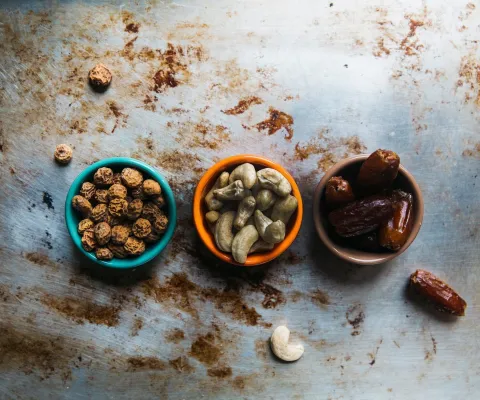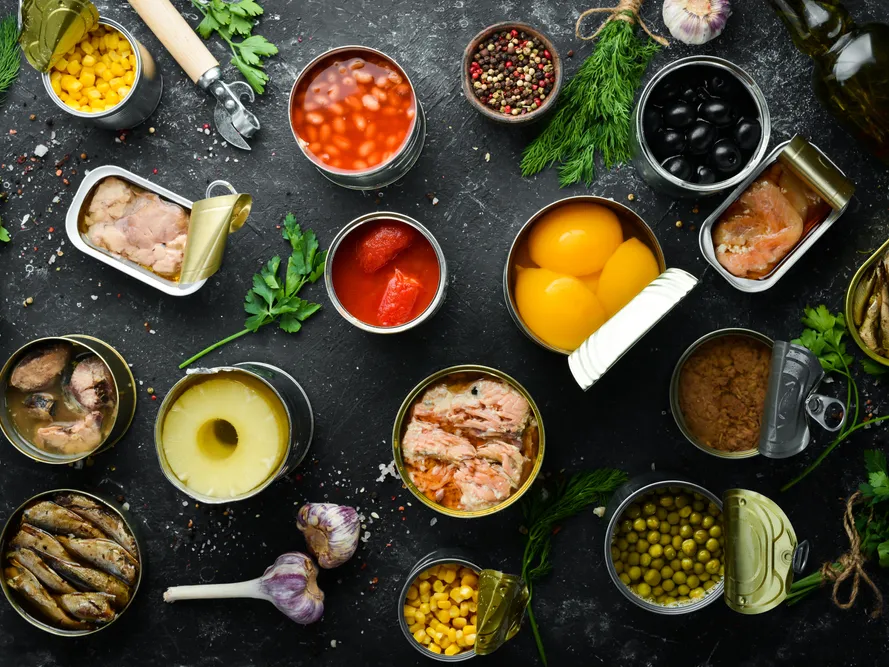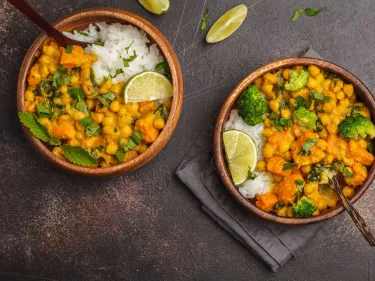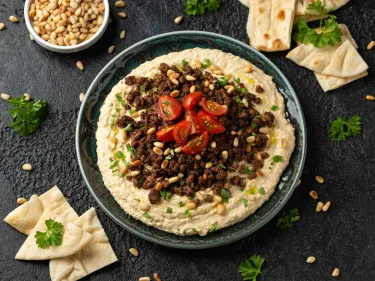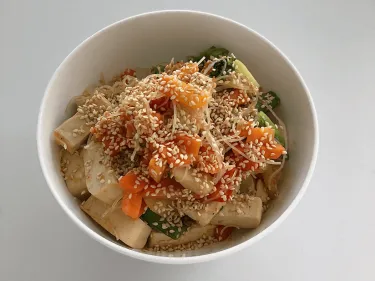Adding canned foods to your shopping trolley can be a cheap and easy way to eat more fruits, vegetables, and legumes, and add protein and fibre to your meals. They are also a great backup when you need to make a healthy meal in a hurry. Whilst there are many different foods that are canned, some are better than others.
We’ve put together a list of 10 tips on what to look for when buying canned foods, and how to include canned foods in your cooking:
1. Check the salt
Often brine (salty liquid) is used in canning, however other liquids can also be used. Look for products that have ‘no added salt’ listed on the label. Compare different brands and products and choose the one with less sodium, ideally less than 120mg/100g.
For vegetables and legumes, you can reduce some of the salt content by rinsing the vegetables (not canned tomatoes) under running cold water before using them.
2. Check the sugar
Canned products often contain added sugars for flavour and preservation. You will find sugars listed on both the ingredients list and the nutrition information panel. Sugar may appear in canned foods under names such as juice, syrups, molasses and honey. Choose products that have ‘no added sugar’ or are canned in juice, rather than syrups, for a healthier choice.
3. Vegetables
Add variety to your meals by using a mix of fresh, canned and / or frozen vegetables. Canned vegetables such as crushed tomatoes are a great base for pasta sauces, canned corn and kidney beans can add colour and fibre to a Mexican bean nachos, and why not add some canned beetroot to your burger? They all count to your 5 serves of vegetables per day.
Add canned vegetables to your repertoire this week, with these recipes:
Healthy Tomato Braised Eggs Recipe | No Money No Time
Healthy Beef & Vegetable Burgers Recipe | No Money No Time
4. Legumes
Canned legumes (e.g. chickpeas, kidney beans, and lentils) are a good source of protein, and prebiotics that are good for gut health, and are a great way to increase the fibre in your meals. Try substituting some or all the chicken in your favourite curry with chickpeas or swap out half of the mince in your Bolognese for a can of brown lentils instead. Legumes are also a great way to reduce the cost of your meals, whilst still being filling and great for your health.
Add legumes to your menu this week using one of these recipes:
Healthy Black bean quesadilla with speedy guacamole Recipe | No Money No Time
Healthy Vegetarian Nachos Bowl Recipe | No Money No Time
5. Fruits
Canned fruits are a great way to add variety to your meals, particularly when certain fruits are out of season. Canned fruits are often sneaky sources of added sugars, so look for fruits canned in juice, rather than syrups, and without added sugars (check the ingredients list!). Try adding some canned passionfruit pulp or peaches to your morning muesli, pineapple to your pizza, or make a smoothie with canned mangos.
6. Baked beans
Breakfast, lunch, dinner, or a snack, baked beans are undeniably versatile, being both a good amount of protein, fibre and can count to your daily serve of vegetables. Look for baked beans with “no added salt” or “reduced salt”, and pair them with wholegrain toast or eggs to make it a meal.
7. Light Evaporated milk
Light evaporated milks can be used as an alternative to cream used in curries and pasta dishes, that will help reduce the amount of saturated fat and energy in a meal, whilst still providing the desired creaminess.
8. Proteins
Canned tuna, sardines, mackerels and salmon are a convenient source of protein, and healthy fats that require no additional cooking, and can be easily mixed into a salad, pasta or rice dish, or added to a sandwich. Choose options that are lower in salt and add flavouring yourself with different herbs and spices.
Add canned fish to your menu this week using one of these recipes:
Healthy Tuna & Vegetable Fritters Recipe | No Money No Time
Healthy Quick Salmon & Pasta Salad Recipe | No Money No Time
9. Dents and damage
Canned foods are a great pantry staple because they last longer than their fresh alternatives. This is because during the canning process, foods are heat treated to kill off bacteria, and a vacuum seal created. Different liquids are used in the canning process to help keep bacteria growth at bay. However, sometimes cans become dented, or damaged, which can mean that the sterile environment created during the canning process is compromised. Choose canned foods without dents, and avoid cans that have signs of swelling, leakage, rust or scratches, broken seals, or are damaged.
10. Storage
Check the label for any special storage instructions. However, most canned foods can be stored safely in a cool dark cupboard, at room temperature or below for around 12 months. Avoid storing canned foods in direct sunlight.
Once opened, transfer any unused food from the can into a clean storage container with a lid (don’t store unused food in the open can), and use within the time specified on the container, often 1-3 days after opening.
Read more about how to choose, use and store canned foods on the Food Standards Australia and New Zealand website.
Check out our Pantry staples list for the types of canned foods to keep in your pantry.
